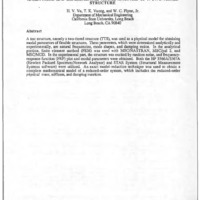-
Title
-
Analytical And Experimental Modal Analysis Of A Two-Tiered Structure
-
Report Number
-
WL-TR-91-3078 Volume I, p. DAB-1 thru DAB-11
-
Creator
-
Vu, H. V.
-
Vuong, T. K.
-
Flynn, Jr., W. C.
-
Corporate Author
-
Department of Mechanical Engineering,California State University, Long Beach
-
Laboratory
-
Wright Laboratory
-
Date
-
1991
-
Date Issued
-
1991-08
-
Extent
-
11
-
Contract
-
Laboratory Research - No Contract
-
DoD Project
-
2401
-
DoD Task
-
240104
-
Identifier
-
ADA241311
-
Format
-
1 online resource
-
Abstract
-
A test structure, namely a two-tiered structure (TIS), was used as a physical model for obtaining modal parameters of flexible structures. These parameters, which were determined analytically and experimentally, are natural frequencies, mode shapes, and damping ratios. In the analytical portion, finite element method (FEM) was used with MSC/NASTRAN, MSC/pal 2, and MSC/MOD. In the experimental part, the structure was excited by random noise, and frequency-response function (FRF) plot and modal parameters were obtained. Both the HP 3566N3567 A (Hewlett Packard Spectrum/Network Analyzer) and STAR System (Structural Measurement Systems software) were utilized. An exact model-reduction technique was used to obtain a complete mathematical model of a reduced-order system, which includes the reduced-order physical mass, stiffness, and damping matrices.
-
Description
-
A test structure, namely a two-tiered structure (TIS), was used as a physical model for obtaining modal parameters of flexible structures. These parameters, which were determined analytically and experimentally, are natural frequencies, mode shapes, and damping ratios. In the analytical portion, finite element method (FEM) was used with MSC/NASTRAN, MSC/pal 2, and MSC/MOD. In the experimental part, the structure was excited by random noise, and frequency-response function (FRF) plot and modal parameters were obtained. Both the HP 3566N3567 A (Hewlett Packard Spectrum/Network Analyzer) and STAR System (Structural Measurement Systems software) were utilized. An exact model-reduction technique was used to obtain a complete mathematical model of a reduced-order system, which includes the reduced-order physical mass, stiffness, and damping matrices.
-
Distribution Classification
-
1
-
Distribution Conflict
-
No
-
DTIC Record Exists
-
No
-
Illinois Tech Related
-
No
-
Photo Quality
-
Not Needed
-
Report Availability
-
Full text available
-
Type
-
article
 article23
article23